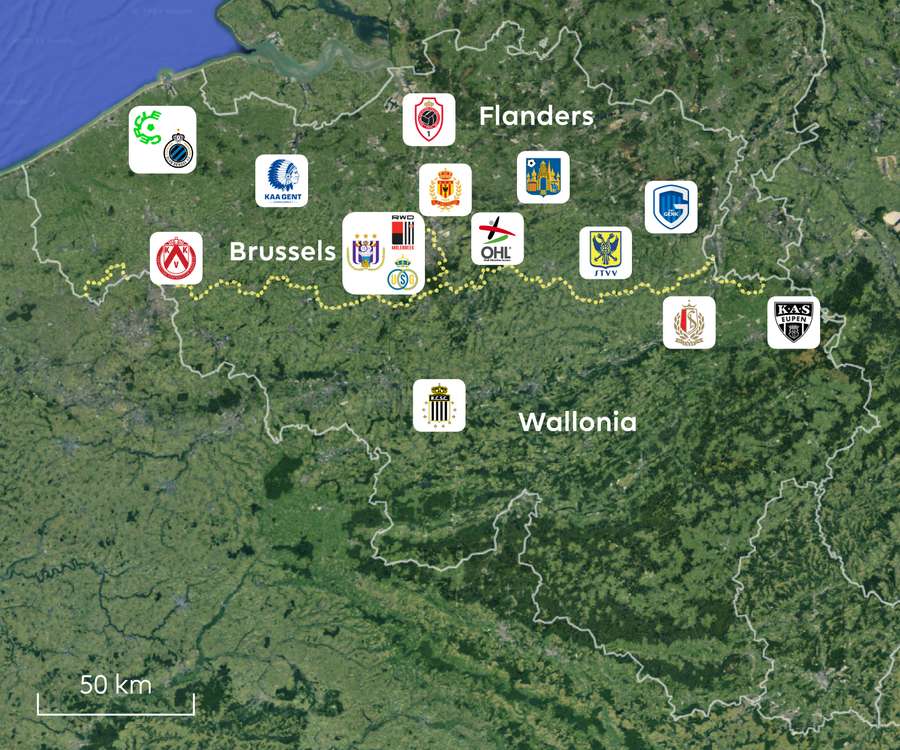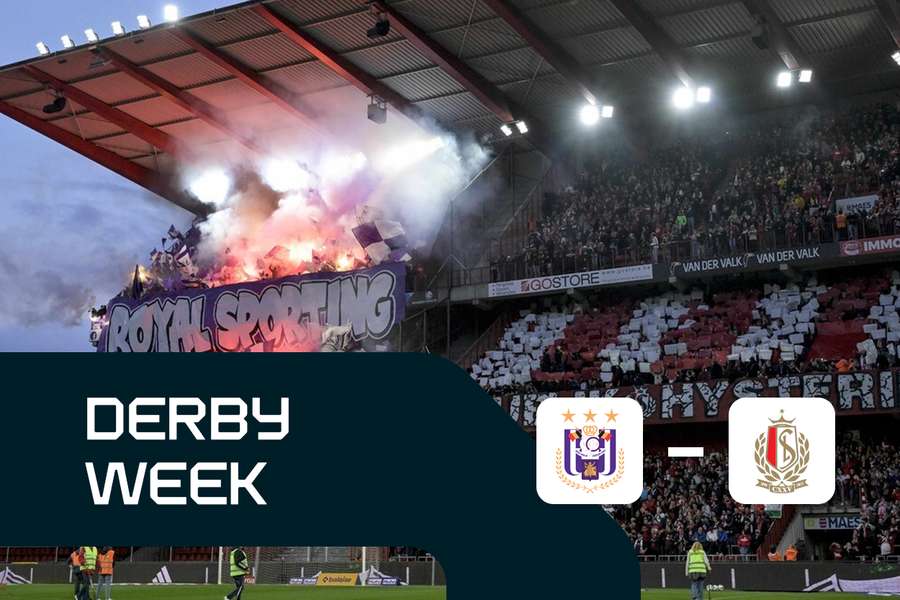This results in many different rivalries and derbies. One of the biggest matches is the clash between Anderlecht from the capital Brussels, and Standard Liege, two historically very successful clubs. In addition, the so-called "Belgian Clásico" is on the schedule twice this week.
Belgium is a small but densely populated country, with a mix of cultures and languages. The country has three official languages - Flemish (which is a dialect of Dutch), Walloon French (which also differs very little from classical French) and German. The three communities that speak them divide Belgium into three so-called communities. The Flemish community has the largest population (about 59%), the Walloon community has 40%, and the small German community has less than 1% of the population.
Administratively, however, Belgium is divided up a little differently. The country's most striking divide is based on the predominant language and culture - the border between Flanders in the north and Wallonia in the south. The small German-language enclave in the east of the country, on the border with Germany, falls administratively under Wallonia. The third large autonomous region is the capital Brussels, which is linguistically mixed but predominantly French. All three main administrative units have their own government and parliament.

The whole country is all the more complex because its population is far from being made up of just the three linguistic (national) communities mentioned above. Data from the local statistics office in 2021 show that 67.3% of the population is of Belgian ethnic origin. The remaining 32.7 % have roots elsewhere. And according to the survey results, a full 74.5% of the population of the Brussels region is of non-Belgian origin.
Immigrants from North Africa (especially Morocco and Algeria), sub-Saharan Africa (especially Congo) and Turkey, but also from other European nations (especially Italians, French and Portuguese) are large groups. Out of a total population of 11.5 million, one of the largest groups of 'non-Belgian' origin is the Moroccan Belgians (about 350,000), who are the largest Arab ethnic enclave. The demographic, cultural and linguistic diversity is naturally reflected in the Belgian football environment.
The Belgian derby? All against all
Football is something that unites Belgians as a nation. Yet even here, the question of nationality and language is fragile. In order to avoid disputes between the Flemish and the Walloons, it has been an unwritten rule in recent years that the Belgian national team is led by a foreign coach and that the official language in the booth is English. Even football clubs are divided into Francophone and Dutch-speaking clubs. However, the proportion of these within the top competition is very uneven.
The map of the 2023/24 top league teams shows that Flanders has the stronger teams. Even there, however, the clubs compete strongly (perhaps because there are so many in Flanders) and there are strained relations between them. The biggest Flemish derby, the so-called Battle of Flanders, is the match between Club Brugge and KAA Gent. Historically, the most successful Walloon sides are Standard Liege and Royal Charleroi, and their rivalry has come to be known as the Walloon Derby. Eupen represents the German-speaking population.
There are also a number of derbies at regional level in Belgium, such as the Limburg derby between KRC Genk and Sint Truiden. A traditional contest between city rivals is the Bruges City Derby (Club Brugge - Cercle Brugge). Only recently have more clubs from Brussels met on the league scene. The traditional Anderlecht has been joined by the historically successful but decades-dormant Royale Union Saint-Gilloise, and since the current edition, RWD Molenbeek have been among the elite.
The biggest rivalry, however, is between the different cultural communities. For the predominantly Flemish-speaking part of Belgium, the biggest match is the clash between Club Brugge and Anderlecht. The match, which is referred to as the Topper ('Top' match) or De Klassieker ('The Classic'), is a battle between two of Belgium's most historically successful clubs. Anderlecht have won 34 championship titles, Club Brugge 18. The rivalry between the two sides began in the 1970s, when Brugge first began to threaten the RSC's privileged position within domestic football.
Naturally, Anderlecht is also the biggest rival for the Walloons and the best Walloon side, Standard Liege, who are 10 times champions of Belgium. However, the rivalry between the two clubs is not just a rift between the Walloons and the people of the capital, there are many more roots of mutual hatred.
The Belgian Clásico
Anderlecht and Standard first faced each other in 1919. Since then, they have clashed in 226 matches, with the Brussels team winning 95 of them and their opponent winning 68. Most recently, earlier this season, Liege managed to win the Belgian Clasico from 2-0 down at half-time to win the game 3-2.
The two rivals have been the biggest competitors sportingly since the 1950s. In 1958, Liege won their first title and added several more in the following years. Between 1961 and 1972, no team other than Anderlecht or Standard won the Belgian league. The Purples (Les Mauves) - or Violets as they are nicknamed after Anderlecht's main club colour - and the Reds (Les Rouches) of Liege were the clear kings of Belgian football during this era.
Apart from the sporting rivalry and natural competition between the capital and Lutych as the largest centre of Wallonia, the mutual antipathy between these camps stems from the nature of the population of both cities.
Anderlecht has historically been a royal club (the full name is Royal Sporting Club Anderlecht) and has been considered representative of the bourgeois society of the metropolis. Liege has been one of the main industrial centres of Europe since the beginning of the Industrial Revolution (it is known as a steel town) and remains so today - although the focus has shifted from heavy industry to high-tech sectors or even food (for example, the brewery Jupiler, the main sponsor of the Belgian league, is based in Liege).
Drastic banners, broken bones, red cards
The rivalry is strongly manifested both on the pitch and in the stands. In 2009, the two rivals battled it out for the title, which was eventually won by Standard. The very next derby at the start of the 2009/10 season was marred by a serious injury to Anderlecht's Polish defender Marcin Wasilewski, whose leg was broken for a year after a hard foul by Axel Witsel. The famous Luthych graduate was shown a red card and given an eight-match suspension. He was also sent off in the next match between the two rivals.
The hateful atmosphere between these clubs is also illustrated by a situation in 2015, when during a match against Anderlecht, Standard's home fans displayed a huge banner with Steven Defour's severed head and the words "red or dead". Defour was a player for Liege and was even captain of the team that won the title in 2009. He then moved to FC Porto, only to betray the red Standard jersey when he returned to Belgium in 2014 by transferring to the purple of Anderlecht.
The first Belgian Clasico of the season brought a record attendance to the stadium. Nearly 27,000 spectators watched Standard's win at the stadium in Liege. There is always a lot of emotion surrounding a match between Anderlecht and Standard and this week they will clash twice. First, they will meet in the Cup semi-final on Thursday at 20:30 CET, with the rematch taking place three days later at 18:30 CET in the 17th round of the Jupiler League. In both cases, Anderlecht will have the home advantage.
Other derbies of the week:
Wednesday, December 6th
France - Ligue 1
Olympique Marseille - Olympique Lyon
Choc des Olympiques (Clash of the Olympiques)
Olympique Marseille and Olympique Lyon are two of France's biggest clubs. Both have their arch-rivals elsewhere. In the case of Marseille, their rival is PSG from the capital. For Lyon, the biggest opponent is nearby Saint-Etienne. Still, the clash between the two teams named Olympique is very prestigious. The match, which was postponed on October 30th due to an attack on the Lyon team bus by Marseille supporters, will now be played.
Saturday, December 9th
Turkey - Super Lig
Besiktas - Fenerbahce derbisi
Besiktas and Fenerbahce, along with Galatasaray, form the strongest trio of clubs in Turkey. All based in Istanbul, great rivalry exists between each other across the board. Fenerbahce is historically the most successful side in the country (28 titles), with Besiktas third (21 titles).
Switzerland - Super League
Lausanne-Sport - Servette Geneva
Derby du Lac Leman (Lake Geneva Derby)
Geneva and Lausanne are the two largest cities located on the shores of Lake Geneva (called Lac Leman in French, which dominates this part of the country). And the football representatives of these settlements, Geneva Servette and Lausanne Sport, are both among the top five Swiss clubs.




